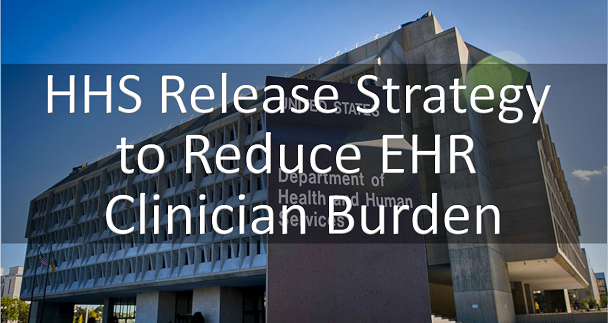HHS Release Strategy to Reduce EHR Clinician Burden
Posted by MDToolbox
on
• Comments
(0)

The U.S. Department of Health and Human Services (HHS) has released their Strategy on Reducing Regulatory and Administrative Burden Relating to the Use of Health IT and EHRs report. This report was required by the 21st Century Cures Act and is intended to reduce the effort and time required by clinicians to meet reporting requirements, record health information, and improve the functionality and intuitiveness of EHRs.
“Usable, interoperable health IT is essential to a healthcare system that puts the patient at the center” said HHS Secretary Alex Azar. “We received feedback from hundreds of organizations and healthcare providers on this new burden-reduction strategy, and the input made clear that there are plenty of steps still necessary to make IT more usable for providers and maximize the promise of electronic health records.”
Clinician burden is linked to EHR usability, the report was written considering input from more than 200 comments submitted in response to the draft report (released in November 2018) and recommendations. The report details three primary goals:
- Reduce the effort and time required to record information in EHRs for health care providers when they are seeing patients
- Reduce the effort and time required to meet regulatory reporting requirements for clinicians, hospitals, and health care organizations
- Improve the functionality and intuitiveness (ease of use) of EHRs.
“The taxpayers made a massive investment in EHRs with the expectation that it would solve the many issues that plagued paper-bound health records,” said CMS Administrator Seema Verma. “Unfortunately – as this report shows – in all too many cases, the cure has been worse than the disease. Twenty years into the 21st century, it’s unacceptable that the application of Health IT still struggles to provide ready access to medical records – access that might mean the difference between life and death. The report’s recommendations provide valuable guidance on how to minimize EHR burden as we seek to fulfill the promise of an interoperable health system.”
Specifically, ONC and CMS looked at four key areas and offered strategies to address each area:
- Increasing public health reporting by working to increase provider PDMP queries, increasing adoption of EPCS, and developing a process to address the issue of inconsistent data collected by federal, state, and local programs.
- Reducing clinical documentation requirements by leveraging health IT to standardize data and processes around ordering services and by reducing required documentation for patient visits.
- Increasing health IT usability and standardization by promoting user interface optimization, promoting harmonization surrounding clinical content such as medication information, and simplifying order entry in EMRs to reduce burden.
- Standardizing federal health IT and EHR reporting by simplifying program requirements such as the Merit-based Incentive Payment System (MIPS) and the Medicare Promoting Interoperability Program.
MDToolbox is optimistic that the medical industry will soon see improvements that stem from the research and public commentary addressed in this report as it is used to affect coming regulations and standards. We are proud to have already addressed some of the key strategic areas for improvement detailed in the report. With MDToolbox, providers have access to tools such as Electronic Prescribing of Controlled Substances (EPCS), convenient on the go e-prescribing with our mobile app, and prescribers can register for our PMP-gateway access option in most states. Our engineers are continually developing methods and workflows to save providers and medical staff time and energy. We offer a free 30 day free trial, so Contact us for more information!